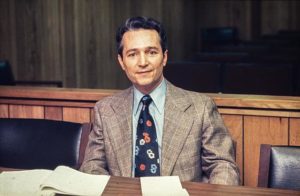Death of O.J. Simpson Stirs Memories of T. Cullen Davis
Like many Americans, I lost a bit of faith in the Justice System the day O.J. got off the hook. I thought the evidence was insurmountable. But all it takes is a reasonable doubt. And O.J. had two things going for him: race and money. Simpson hired the best lawyers money could buy to do two things. To pick a favorable jury and to create that doubt.
In the seventies, a Fort Worth oil tycoon was tried twice.
He was first charged with murdering his 12-year-old stepdaughter. Two years later, he was charged with soliciting a hit man to murder his ex-wife and a judge. Race did not play a part, but money did. Like Simpson, Cullen Davis could afford the best lawyers and, in both cases, he walked free.
Random Samplings is brought to you by the Texas Public Policy Foundation.
To paraphrase an oft-remembered quote: The trial by jury system is the worst system in the world except for all the others.
Until such time when we are all chipped and wearing body cameras by force of law, there is always room for reasonable doubt. Really good attorneys are really good at creating it. They’re also really good at picking juries. In the Simpson case, half the work was already done when the case was moved to downtown Los Angeles and 9 black people were chosen.
In the Davis case, everybody was white including the victims, most of the witnesses, and Davis himself, so race didn’t play a part. Money played a huge part.
At his first trial, Davis was estimated to be worth more than $100 million. In today’s dollars that would come to about $540 million – plenty of dough to buy the best lawyer he could find.
He chose a Texas defense lawyer named Richard “Racehorse” Haynes. At that point, the pieces were in place to get him off the hook. But the trial took some twists and turns, and in an era with no Court TV, virtually everybody in Texas (and I assume other parts of the country as well) followed the case on radio, local TV newscasts, and predominately in the two big newspapers in DFW, the Fort Worth Star-Telegram and the Dallas Morning News.
Who is T. Cullen Davis and what was he accused of?
Davis, still alive at this writing, was believed to have been the richest person ever to go on trial for murder at the time. He lived at Stonegate Mansion, a five-bedroom, 11-bath mansion with an indoor pool and a gigantic master bedroom.
I was working as a reporter for KRLD in Dallas at the time, and on February 10, 1977, I was sent to Judge Tom Cave’s courtroom in Fort Worth to cover the preliminaries. Here’s what I wrote in my 1994 memoir, The Last Great Days of Radio:
Judge Cave had called the media to his courtroom to lay down the law. He told us the jury would be sequestered and we were not to publicize where they would be staying. He agreed to set up an interview room for the media, but said no witnesses could be interviewed until after he had released them. This case will be “no circus” he said. “The more calm and cool, the better.” He asked how many seats the media would need and announced that press badges would be issued. KRLD sent another reporter to cover the actual trial.
I’m relying on Wikipedia for dates and other parts of the case I don’t remember after all these years, and you can check their T. Cullen Davis entry for a more complete summary of the facts. But it boils down to this:
Davis was accused of two murders, those of this 12-year-old stepdaughter Andrea Wilborn, on August 2, 1976, and Stan Farr, a former TCU basketball star. CBS’s “48 Hours” put it this way:
On the night of August 2, 1976, former college basketball star Stan Farr and his date, Priscilla Davis, a petite soon-to-be-divorcee, returned to her home after a night on the town with friends and were met by a man dressed in black and a hail of bullets. When the gunfire ended, Farr was dead, while Priscilla Davis and one her friends was wounded. Also dead was Andrea Wilborn, Priscilla’s 12-year-old daughter from a previous marriage, who was believed to have been shot before the adults got home. Who was the man in black and why did anyone want them dead? It’s a case that has rocked Texas since bullets flew on that night in Fort Worth.
The sex, drugs, infidelity, murder, and utter depravity in this story rocked Texas, and became the basis for a short story I wrote in the eighties and published in my collection Darker Secrets, entitled “The Man in Black.” I fictionalized the story, and of course, had it all solved by the end of the tale. In real life, it was far more complex. As a movie script, no one would have believed it.
RELATED: DEREK CHAUVIN AND O.J. SIMPSON AT OPPOSITE ENDS OF INJUSTICE
Racehorse Haynes never put Davis on the stand. Instead, he attacked the evidence (or lack of) and the testimony of Priscilla Lee Childers Davis who was in the process of a bitter divorce with Davis. Haynes painted her as a sleazy, doped-up unreliable witness. She identified Davis as the killer, saying he wore no disguise except a wig. Haynes’ cross-examination of Priscilla may have been the turning point.
It’s interesting that headwear played a part in the Davis and Simpson cases. Lawyer Johnnie Cochran claimed that even if O.J. was wearing a stocking cap, it would still be easy to identify him (“If it doesn’t fit, you must acquit”). Haynes claimed that Priscilla was an unreliable witness and could not have identified Cullen in a wig as she claimed. Good lawyers use the facts to best advantage.
Davis was acquitted and never was tried for the murder of Stan Farr. But he was tried again!
In 1978, law enforcement officials had an airtight case against Davis. They accused him of hiring a hit man to assassinate both Priscilla, and the judge presiding over the divorce. My memory may be faulty, but I recall seeing the photo in the newspaper of the open trunk of a car with a bloody photo of the supposedly-dead judge. This was staged to show to Davis as proof of the hit. The prosecution also had tape recordings of Davis with an undercover agent posing as a hit man. It wasn’t enough.
Racehorse Haynes brought in an expert who testified that the tape did not constitute solicitation of murder. Davis took the stand and claimed it was all a plot to frame him. Davis’ only punishment was losing his oil fortune in a recession in the eighties. He was later born again, and become a Christian associated with televangelist James Robison.
And what of our system of justice?
I can only tell you what I think. I think we have the only system – trial by a jury of peers – that is possible in a free country. But it has flaws. Here are some of them:
- Race can be used for “jury nullification” as in in the Simpson trial.
- High-powered lawyers can twist the facts as in the Simpson and Davis trials.
- Poor defendants get court-appointed lawyers who may or may not represent them well.
- Prosecutors and defense lawyers try to win cases through jury selection.
- Prosecutors have been known to manufacture or suppress evidence.
- Political correctness has crept into the system as in the Derek Chauvin case.
- Judges sometimes get political as in the various Trump cases.
I have covered many high-profile cases in my radio news career. The first trial I was assigned to cover was a big one. I was a college student working at KTEM when the trial of Rene Adolpho Guzman and Leonardo Ramos Lopez was moved to Belton, Texas on a change of venue. They were charged with executing three Dallas sheriff’s deputies along the Trinity River. Deputies who testified cried on the stand. Henry Wade (of Roe v. Wade) was the Dallas DA. He made an error during final arguments and they had to retry the case.
In Dallas, I covered the murder trial of Randall Dale Adams, accused of murdering officer Robert Wood. The trial became the subject of a film, “The Thin Blue Line,” that resulted in Adams’ being exonerated. Did the prosecution stack the deck as charged by the defense lawyer? Then, who killed officer Wood?
In Waco, I covered the murder trial of David Wayne Spence in the Lake Waco triple murder case in the eighties. During one of the hearings, I sat next to District Attorney Vic Feazell, who recently became the subject of a Netflix documentary “The Confession Killer,” which concerned the controversies surrounding self-proclaimed mass murderer Henry Lee Lucas.
I wrote about these cases extensively in The Last Great Days of Radio. Covering cases such as these is an education that may rival going to law school. I formed many opinions about what goes on in courtroom – especially in capital cases that involve the very rich, or the very poor. Republicans, noting the differences in cases involving Donald Trump with similar cases involving Hillary Clinton or Joe Biden, often charge that we have a dual system of justice. They say there’s a softer, more lenient system for prominent Democrats, while the book gets thrown at Trump. I don’t disagree.
But I’ll point out what I consider to be the most important flaw in our criminal justice system: that race and money can play such an outsized role. When someone is charged with murder, the trial ought to be about just one thing: Did he do it?
 Lynn Woolley is a Texas-based author, broadcaster, and songwriter. Follow his podcast at https://www.PlanetLogic.us. Check out his author’s page at https://www.Amazon.com/author/lynnwoolley. Order books direct from Lynn at https://PlanetLogicPress.Square.Site. Email Lynn at lwoolley9189@gmail.com.
Lynn Woolley is a Texas-based author, broadcaster, and songwriter. Follow his podcast at https://www.PlanetLogic.us. Check out his author’s page at https://www.Amazon.com/author/lynnwoolley. Order books direct from Lynn at https://PlanetLogicPress.Square.Site. Email Lynn at lwoolley9189@gmail.com.
Prepare to order. Time is of the essence.


